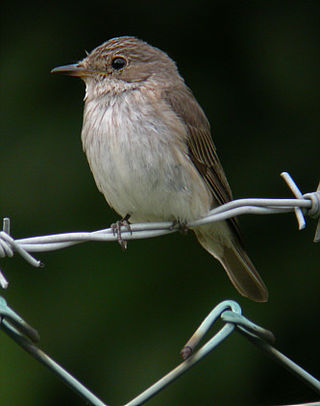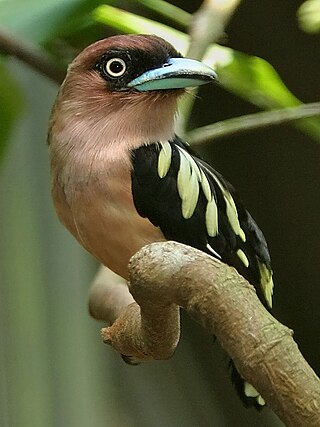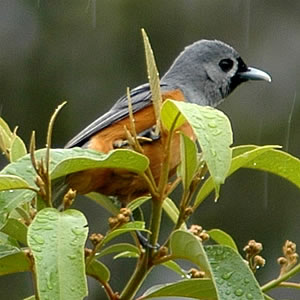
Fantails are small insectivorous songbirds of the genus Rhipidura in the family Rhipiduridae, native to Australasia, Southeast Asia and the Indian subcontinent. Most of the species are about 15 to 18 cm long, specialist aerial feeders, and named as "fantails", but the Australian willie wagtail is a little larger, and, though still an expert hunter of insects on the wing, concentrates equally on terrestrial prey.

True thrushes are medium-sized mostly insectivorous or omnivorous birds in the genus Turdus of the wider thrush family, Turdidae. The genus name Turdus is Latin for "thrush". The term "thrush" is used for many other birds of the family Turdidae as well as for a number of species belonging to several other families.

The boat-billed flycatcher is a passerine bird. It is a large tyrant flycatcher, the only member of the monotypic genus Megarynchus.

The great kiskadee, called bem-te-vi in Brazil, pitogue in Paraguay, and benteveo or bichofeo in Argentina, is a passerine bird in the tyrant flycatcher family Tyrannidae. It is the only member of the genus Pitangus.

The paradise flycatchers (Terpsiphone) are a genus of birds in the family Monarchidae. The genus ranges across Africa and Asia, as well as a number of islands. A few species are migratory, but the majority are resident. The most telling characteristic of the genus is the long tail streamers of the males of many species. In addition to the long tails the males and females are sexually dimorphic and have rufous, black and white plumage.

The Ficedula flycatchers are a genus of Old World flycatchers. The genus is the largest in the family, containing around thirty species. They have sometimes been included in the genus Muscicapa. The genus is found in Europe, Asia and Africa. Several species are highly migratory, whereas other species are sedentary.

The restless flycatcher or restless myiagra is a passerine bird in the family Monarchidae; it is also known as the razor grinder or scissors grinder because of its distinctive call. It is a native of eastern and southern Australia. Populations in New Guinea and northern Australia, which were at one time considered to be a subspecies, are now accepted as a separate species, the paperbark flycatcher. It is a small to medium-sized bird and has similar colouring to the willie wagtail.

Pachycephala is a genus of birds native to Oceania and Southeast Asia. They are commonly known as typical whistlers. Older guidebooks may refer to them as thickheads, a literal translation of the generic name, which is derived from the Ancient Greek terms pachys "thick" + kephale "head". This lineage originated in Australo-Papua and later colonized the Indonesian and Philippine archipelagos to the west and the Pacific archipelagos to the east.

Muscicapa is a genus of passerine birds belonging to the Old World flycatcher family Muscicapidae, and therein to the typical flycatchers of subfamily Muscicapinae. They are widespread across Europe, Africa and Asia with most species occurring in forest and woodland habitats. Several species are migratory, moving south from Europe and northern Asia for the winter.

Drymophila is a bird genus in the antbird family (Thamnophilidae). It is a relative of the typical antwrens.

The shrikebills are the monarch flycatcher genus Clytorhynchus. The five species have long laterally compressed bills similar to true shrikes that give them their names. The genus is endemic to the islands of Melanesia and western Polynesia.

Eurylaimus is a genus of broadbills found in Southeast Asia.

Monarcha is a genus of bird in the family Monarchidae. They are found in Australia and Melanesia.

Myiagra is a genus of passerine birds in the family Monarchidae, the monarch flycatchers, native to Australasia, sometimes referred to as the broad-billed flycatchers or simply broadbills.

The Guam flycatcher, or Guam broadbill, is an extinct species of bird in the family Monarchidae formerly endemic to Guam.

The oceanic flycatcher is a species of bird in the family Monarchidae. It is endemic to Micronesia and can be found on the Caroline Islands. The diversity of traits in the Oceanic flycatchers resulted from three waves of colonization in non-overlapping times, which led to situ specification events on Micronesian islands.

Pomarea is a genus of birds in the monarch flycatcher family Monarchidae. The genus is restricted to the islands of Polynesia. The monarchs of this genus are around 15–19 cm long and most have sexually dimorphic plumage.

Trochocercus is a genus of bird in the family Monarchidae. Described by Jean Cabanis in 1850, the name Trochocercus is a combination of the Greek words trokhos meaning "circular" or "round" and kerkos, meaning "tail".

The suiriri flycatcher is a species of bird in the family Tyrannidae found in semi-open habitats in South America. It was formerly split into two species; the Chaco suiriri and the Campo suiriri. Suiriri originates from Guaraní, where it is a generic name used for several medium-sized tyrant flycatchers.

The white-bellied blue robin or white-bellied sholakili, is a bird of the family Muscicapidae. It is endemic to the Shola forests of the higher hills of southern India. The Nilgiri blue robin and this species were once considered separate species, later lumped as sub-species of a single species (major) and elevated again to full species in 2005 by Pamela C. Rasmussen. The species was earlier thought to be related to the shortwings and placed in the genus Brachypteryx and later moved to Myiomela since species in the genus Brachypteryx shows marked sexual dimorphism. In 2017, a study found that this is a sister group of the flycatchers in the genera Niltava, Cyornis and Eumyias among others. It was then placed in newly erected genus Sholicola. This small bird is found on the forest floor and undergrowth of dense forest patches sheltered in the valleys of montane grassland, a restricted and threatened habitat.




















